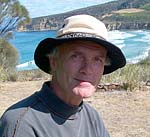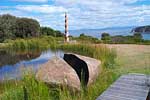I'm a self-taught wood turner. That didn't satisfy me in some way, there was something missing. So I toddled off to the Canberra School of Art and spent a couple of years there doing a furniture-based wood course.
Wood designer-maker Peter Adams

Having the opportunity as a youngster to spend my summers in the forests and lakes of Northern Michigan I'm sure has affected what I'm doing right now. I remember being in the forest and playing with sticks, assembling them, and liking the feeling of being with the trees.
In 1985 I was invited to lecture at the University of Tasmania. I intended to come just for a year and go back to America where I had friends, my business, a good place to work and live. But Tassie hit me quite deeply and 18 years later I'm still here.

Windgrove, where I live, is a 100 acre coastal property. To me it's like a large canvas that I've inherited. As the years go by, I'll slowly add to it. I've added a climbing track and a peace garden so far. Along the track I've put 14 stations or meditation sites where I've put my wooden benches. And in between those I'll be putting what I call poem posts: people will see a vertical sculpture and they'll be able to take a tablet off it and read a poem that's appropriate to where they're standing.
It's using art that's either visual or literary to stroke people's imagination, to fuel an alternative way of behaving, to remind them of their connectedness to their surroundings. What I'm trying to do more than anything is change the way people behave.
I don't know if it's more effective than something else. I know it's very powerful. I had one felllow from Germany visit the peace garden. He was in a concentration camp. He went from the split rock in the garden, which is about our hearts being broken open to compassion and he was crying, real tears, because it brought back those possibly painful memories, but then when he got to the spiral of hope he felt this calm return. And for him it was a profoundly moving experience. That's the artwork having an impact with people's emotions and souls and spirits. It's very gratifying to me.
I've always done benches or coffee tables as the predominant line. I've always liked that low horizontal form which requires the verticality of a human being to add to it, to complete it. With a bench, you have to sit on it for it to be a complete work and I like that connection. I still do that. I like the bench for the idea that two people can sit next to each other on the same piece of timber and be connected.
In my lifetime, I've had four friends commit suicide. I've seen wars. My ancestry is half-Serbian and so I was in Yugoslavia just before the civil war and in Vietnam. Being in Tasmania you are well aware of what's happening to the forests here. How humans with ignorance are destroying this huge library of information.
I have to use my art to effect change. I have to create ways for humans to sit down and start dialoguing. Not only change within themselves so they don't suicide, but how to change behaviour between people and how they behave towards the natural world.
The bench form to me seemed the logical place to start. If I could create benches that allowed people to dialogue with each other, to listen, to hear the truths of another person, in my own small way I can help that process. And that's how it all began. I started putting benches along the path, decided to build a big peace garden as the starting point. And as the years go on, I'll just keep adding to it.
Right now, if I could, I'd just produce work for here. All I really want to do now is create works that bless the earth and bless the human. Not so much something that goes to a gallery or a museum where it's just seen as an object. What I create I see as a living entity – an object to be viewed from or towards. And I don't mind that it will deteriorate and go back to the elements.
Related
I turned to furniture mid-career. I was actually trained as a musician and a high school teacher and I decided to do something else. I'd done a lot of building before and I suddenly decided to build stuff that I was going to sell instead of keep.
About fifteen years ago I bought a little house that I was going to renovate but I could never find anyone to do things exactly as I wanted them.
I was born in Melbourne and I've been in Tasmania for about 14 years. I like Tasmania because I like the bush, I like the weather, I like the timber. It's a much more natural environment than the mainland. The landscape here is inspirational to my work.
My workshop is on part of the family farm and I've lived alongside it or near it all my life apart from the occasions where I've been studying or working overseas or interstate.
I was born in Tasmania. My father was in the timber industry so I was always surrounded by stories of timber and things like that. I left school at 14 to do a trade in joinery. Prior to that I was more interested in making boats.
I came to Australia in 1970 to take up a teaching position at the Tasmanian School of Art. We were probably some of the last of the Ten Pound Poms. I was very keen after going through college in the UK to travel overseas and try other cultures.
I remember carving when I was about 8. I used to steal my mum's lino carving tools. I was able to go down to the workshop in the garage and carve away. I think the first thing I came up with was an acanthus leaf. I was really pleased with that.








